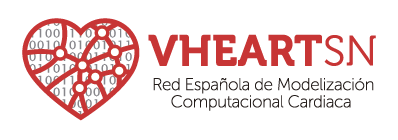The V-Heart network includes practically all the Spanish groups that investigate the computational modeling of the heart. In the network we can find specialized groups in the physiological modeling of electrical activity, from the cellular level to the level of the human body. In addition, the network consists of groups specialized in modeling the mechanical activity and specialized groups in interpreting signals at different levels. It also consists of experts in numerical methods that will facilitate both the development of the models and the implementation of software that allows simulations to be carried out in acceptable times for medical professionals and high-performance computer experts who make the environment available to the Alya network developed at the Barcelona Supercomputing Center (BSC) for the implementation of cardiac computer models.
The V-Heart network is, therefore, a multidisciplinary network that will allow dealing with the complex problems associated with the development of multi-scale models of the heart.
It is important to emphasize that the development of these models, especially those oriented to personalized medicine, will require the collaboration of medical teams that can support the network with the provision of information and the subsequent validation of these models. Members of the V-Heart network have extensive experience in collaboration with medical teams.
The network considers it essential to promote the involvement of private companies both in the support of research and in the development of products based on the research that will be carried out within the framework of the network.
The main characteristics of the groups that are members of the network are briefly described below.
Ci2B
(Centro de Investigación e Innovación en Bioingeniería, Universitat Politècnica de València ) is a research center with more than 20 years of experience in the development of multi-scale models of the heart. The Ci2B has published models of the electrical activity of different cardiac tissues (atrium, ventricle or purkinje fibers). In recent years he has developed methods for the study of cardiotoxicity of drugs and therapies based on radiofrequency ablation based on realistic 3D models of the ventricles and the atria.
BIOFIS-UNAV
More information Presentation UNAV
(Grupo de Biofísica del corazón) is a research group that works on modeling cardiac tissue at different scales. He has been dedicated to this topic for more than 10 years and as an important achievement he has developed numerical methods to study the process of cardiac fibrillation and defibrillation. The goal is to obtain a less invasive defibrillator (low energy).
CoMMLaB
More information Presentation CoMMLab
(Computational Multiscale Simulation Lab) is a multidisciplinary research group dedicated to biophysical simulation and computer animation. Its objective is the development of inverse computer estimation methods to facilitate the construction of personalized electrophysiological models for patients, and to introduce advanced non-invasive diagnostic and planning systems in cardiology.
BIOCOM-SC
(Grupo de Biología Computacional y sistemas complejos) is a research group in computational modeling of biological systems. One of the
main research topics is the modeling of cardiac dynamics, and the mechanisms that give rise to atrial fibrillation. Our models range from the subcellular level, including intracellular calcium dynamics and excitation-contraction coupling, to the level of electrical propagation in tissue and re-entry generation mechanisms, for example fibrosis or dynamic instabilities.
ALYA-BSC
More information Presentation BSC
(Grupo de desarrollo de Alya, Barcelona Supercomputing Center): Alya is a Multiphysics simulation code specially developed to be efficient in large computers. One of the main areas of application is biomechanics, in particular the cardiovascular system, with a strong participation of physicians from different institutions, notably the CNIC. At this time, the ALYA-BSC group is composed of 35-40 researchers: students, programmers and postdocs.
CIMNE-BIOMENG
More information Presentation CIMNE
(Biomedical Engineering Group, International Center for Numerical Methods in Engineering). CIMNE is a research center with more than 30 years of experience in the development of numerical methods and computational techniques for the advancement of knowledge and technology in the area of engineering and applied Sciences. CIMNE-Biomeng focuses on applying these numerical methods in the field of bioengineering. One of the main areas of the group is to process/link medical images with numerical methods for the creation of virtual models of the cardiovascular system.
PHYSENSE
(Sensing in Physiology and Biomedicine) It is a research group focused on integrating mathematical, engineering and basic science knowledge with physiology and clinical medicine, especially in the cardiovascular field. This is achieved through the development of new methodologies for processing and merging multi-modal data, customized computational models and automatic learning algorithms. PhySense has been part of national and international projects transferring the computational models of the heart to answer specific clinical questions, such as predicting the patient’s response to cardiac resynchronization therapy or Study of radio-frequency ablation interventions
BSICoS-I3A
(Biomedical Signal Interpretation and Computational Simulation Group). Modeling and simulation of cardiac electrical activity in healthy hearts and pathologies, including: 1) Study of auricular arrhythmias: atrial activation and manifestations in Electrogram signals (EGM) and electrocardiogram (ECG). 2) Study of ventricular arrhythmias: mechanisms involved in the generation of reentry arrhythmias and risk quantification through markers obtained from the ECG. 3) Dynamic modeling of the evolution of myocardial ischemia. 4) Stochastic modeling of the fluctuations in the ionic currents of the ventricular membrane and analysis of its contribution to the variability of repolarization. 5) Signal processing techniques to extract the information from the EGM, and/or ECG.
